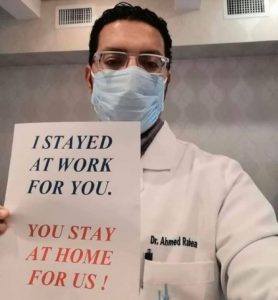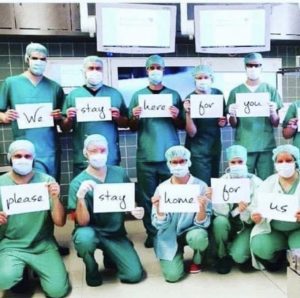| Update 13April2020:
An interesting (though obscure) bit of data I have encountered today. A New York hospital tested 214 pregnant women presenting for delivery for SARS-CoV-2 infection. This is an unusual cohort in that we have been generally restricting testing to symptomatic patients; this was a more-or-less random sample. Thirty-three of the women tested positive, but only four had symptoms. In other words, nearly 88% of the patients who tested positive were asymptomatic! This proves nothing — we still need a lot more data — but strongly suggests that SARS-CoV-2 infection is much more common than we think, but most infected persons might be asymptomatic. It means that it’s more important than ever to stay at home, because you or the folks you encounter might well be infected and not know it. It also means that this disease, while still fatal to a lot of folks, might be a lot less fatal than the data (from testing only asymptomatic people) has led us to believe. This is good news. |
| Update 05April2020:
I am close to 100% telemedicine visits now, which is much safer for me, you, and most important the community. Bert Hubert is taking a break from the Corona Science Journal. For up-to-date information that’s more in-depth than the CDC or WHO, ars technica has a nice coronavirus summary page. The CDC has finally endorsed wearing masks when you are out and about (which shouldn’t be very often, but stuff happens). Masks can remind you not to touch your face and cut down on the number of respiratory droplets you put into or take from the environment. The primary route of transmission still goes from your hands to your eyes/nose/mouth, so you still need to wash your hands, stay home, and keep your distance. Those things are all more important than wearing a mask. Also, just about any kind of mask or bandana will do what most of us need. Until the supply situation is corrected, you should save the medical-quality masks for folks working closely with high-risk persons or in high-exposure situations. |
| Update 29March2020:
Please, please, please consider using telemedicine for your visit. Looking at heat maps of coronavirus spread, we’re in a critical phase. Please understand that you cannot know that you’re not infectious. We cannot know that we’re not infectious. Even if you feel that you’re low risk or you don’t care if you get sick, you are putting yourself, your family members, us, and our other patients at increased risk when you come in — just as you increase the risk to yourself and others every time you visit a location outside your home. Unless you have a situation that absolutely requires an in-person visit, stay home! |
| Update 28March2020:
Drive thru testing is (maybe) available in Sacramento County. Here is more information on it. |
Apparently, these posts always have to start out with an obligatory “the health of our customers is our highest priority.” But I hope you already know and believe that, or you would be getting your health care elsewhere. We wouldn’t be here if your health wasn’t paramount.
What should I do as a patient?
You have all seen this advice already, but it’s not just to pacify you, it’s actually excellent advice:
- Wash your hands.
- Avoid touching your face.
- Wash your hands. You don’t need hand sanitizer; washing with soap and water (even cold water) is better.
- Stay about three feet away from other people and avoid crowds, especially indoors.
- Wash your hands, and be sure to get between your fingers
- If you feel sick (fever, cough, shortness of breath, pain when you take a deep breath) stay home from work or school and contact us.
 This situation is evolving quickly, and I’m not going to have time to keep things up-to-date. Don’t believe everything you see on social media (especially Facebook). A good site for keeping up-to-date is the World Health Organization (WHO). In spite of the deliberate misinformation coming out of Washington these days, The Centers for Disease Control and Prevention (CDC) also has some good updated information. If you want to spend some time reading some medical and epidemiological details, the Corona Science Journal —while not a respected, major organization — brings together a lot of information and links and looks thoughtful to me.
This situation is evolving quickly, and I’m not going to have time to keep things up-to-date. Don’t believe everything you see on social media (especially Facebook). A good site for keeping up-to-date is the World Health Organization (WHO). In spite of the deliberate misinformation coming out of Washington these days, The Centers for Disease Control and Prevention (CDC) also has some good updated information. If you want to spend some time reading some medical and epidemiological details, the Corona Science Journal —while not a respected, major organization — brings together a lot of information and links and looks thoughtful to me.
If you have upper respiratory symptoms (fever, cough, pain with a deep breath, shortness of breath) get in touch and we’ll let you know the latest information we have on testing (and keep reading, there’s more about testing below).
Does any of it matter?
Why yes, it does. You’ll see some misinformation sites that say “staying home from school won’t stop the virus.” Yes, that’s true. The moment for containment has passed. (Actually, I don’t believe we ever had a chance of containing a coronavirus infection—folks have been trying for years and it’s just a difficult thing to do. But I don’t blame people for trying.) The goal at this point is to slow the velocity of transmission, mostly so that our medical facilities aren’t overwhelmed before the pandemic can burn itself out or we get better at controlling and managing it. (I can’t write a treatise on evolutionary virology here, but most pathogenic organisms for a variety of reasons tend to evolve toward being less, not more, deadly.)
What are you doing about it, Doctor?
I’m washing my hands. 🙂 A lot.
You already know that Medical Oasis is a pretty low-key practice, so there are rarely more than one or two folks in the waiting room. Amy has always been rather fanatic about keeping the place clean and sanitized, but she’s being even more diligent these days.
 We’re encouraging more people to have their visits by telemedicine. Read about our telemedicine system and let us know if you want to try it. If it’s appropriate for you, it means you can stay home with your children who aren’t in school, or just avoid more social contact until this thing resolves.
We’re encouraging more people to have their visits by telemedicine. Read about our telemedicine system and let us know if you want to try it. If it’s appropriate for you, it means you can stay home with your children who aren’t in school, or just avoid more social contact until this thing resolves.
Testing has not been nearly as available as Washington would have us believe (and, no, there’s no magic Google web site nor 1,700 Google engineers working on same), but the situation is getting better. We have ten test kits on the way from Quest Diagnostics, but we have no information yet on how much the tests cost and whether insurance will cover them. (As Quest’s tests aren’t FDA approved as of 13March2020, there’s a fair chance insurance won’t cover the testing.)
A note on vocabulary
Coronaviruses are common. They probably account for 40% of colds. This particular coronavirus is more lethal. It is actually named Severe Acute Respiratory Syndrome Coronavirus 2, or SARS-CoV-2. In some ways, it will be confusing to folks in the future who will have to figure out whether a reference to “coronavirus” means “the coronavirus” (SARS-CoV-2) or just a generic coronavirus. But right now, everyone will know what you mean by “coronavirus” and it’s a lot easier than saying SARS-CoV-2 or, egad, “Severe Acute Respiratory Syndrome Coronavirus 2.”
COVID-19 (COronaVIrus Disease 2019) is the designation for the disease that results from infection with SARS-CoV-2.
So be safe. Wash your hands. Isolate yourselves. Keep checking established, reliable news sources. Know that this will likely get better with time.
